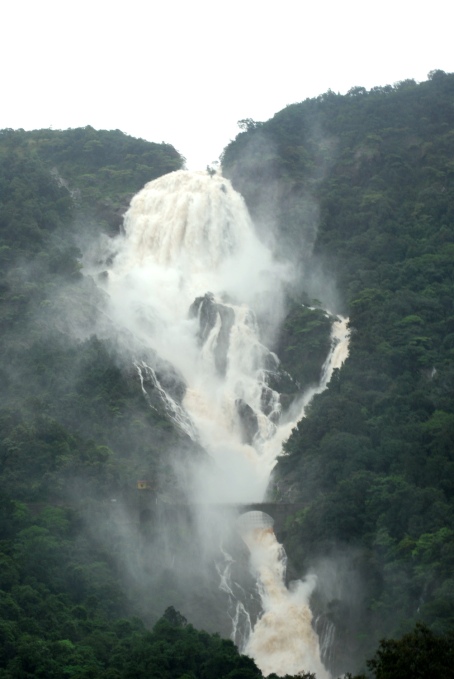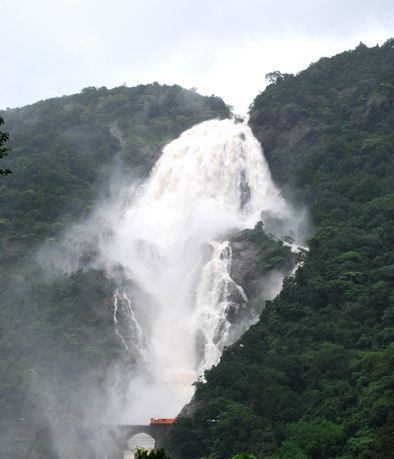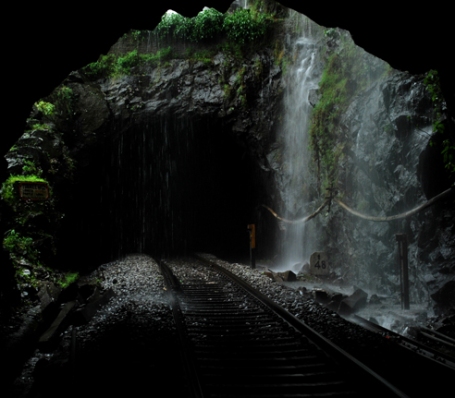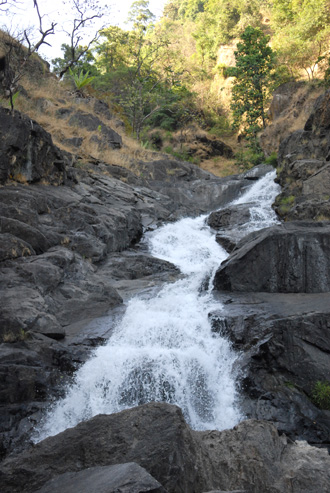Posts filed under ‘Wildlife’
A trek to DOODH SAGAR between Karnataka and Goa
Away from the pristine beaches, Gothic churches that unfold the grandiose of erstwhile Portuguese era, not all are aware of Goa’s rich and bounteous flora and fauna. Predominately relegated to lesser ranks during the rainy season, many tourists debunk places around Goa stating ‘off season’. But for any adventure freak, the touted ‘off season’ in Goa unfolds a sequence of destinations which would test their endurance on par with any other adventure locations in India.

Gifted with the bounteous wealth of nature, Goa boasts of rich natural vegetation. Sandwiched between the Arabian sea and lofty Western Ghats, the eastern areas of Goa within the jurisdiction of Sanguem, Ponda, Canacona are often compared with the tropical forest of Amazon and Cango for their rich biodiversity. The rainy season or the sidelined ‘off season’ unveils the sylvan beauty of Goan forests. Though not easy to explore, the forest areas with steep valleys, thick fog and heavy rains sets up a perfect ambiance for the seasoned rain trek for trekkers.

Rain trek, even though not as popular as any other packages of Goan tourism, is a refreshing experience to encounter the wilderness from a close quarter and the cheapest means of enjoying the nature in Goa. Trekking along the Konkan railway lane cutting might hills and thick vegetation, offers you the guided way to a certain level. Pitch dark railway tunnels spanning several kilometers, pounding rains all through the trek, chilling weather, unique wildlife and bewitching beauty of water falls will charge you with an utmost energy level.

Perched amidst the Bhagwan Mahaveer wildlife sanctuary the Doodh Sagar water falls, which is around 60 kms from the Goan capital Panaji and 30 kms from Margao. Cascading from a height of 600 ft in three different phases, the Doodh Sagar falls is said to be the boundary between Karnataka and Goa. Like any other falls in the Southern plateau, Doodh Sagar too treats you with exquisite charms in its full flux especially during monsoon and post monsoon. The beauty of the falls, similar to the idyllic Eden basking atop lofty mountain cliffs, appears like a stream of milk converging deep inside the earth amidst lush green forest from a distance.

Provided with relatively good infrastructure, the falls is well linked by road and rail network. However, for any trekkers, the rail lane offers a memorable experience. People often trek to the falls in two different routes. A few find it easy to trek from Madgaon (Goa) side while a few wish to trek from the Castle Rock (Karnataka) the last railway station from Karnataka side. But trekkers starting from Madgaon will have better advantage over others in capturing the beauty of the falls as they trek parallel to the falls from a distance spanning a few kilometers. Be prepared to save yourself from leeches and sliding hillocks.

Frequent trains plying between Belgaum and Madgaon will drop you close to the trek route. Starting from Madgaon side, trekkers begin their ardous trek from the Sonalim station which is around 15 km before the Doodh Sagar station and 10 km before the falls. The stretch interspersed with railway tunnels, passing by streams, tall trees of evergreen rain forest and heavy rains will make you run for the cover. Braving the odds till a considerable distance will lead you to makeshift huts of railway gang men. Hailing from the native hamlets around by, these workers will explain you the ‘folk tale’ which lent the name ‘Doodh Sagar’ to the falls.

According to these men, a powerful king lived atop the mountains of Western Ghats along the Goan frontier. His palace was built with pure ivory and embellished with precious stones and beautiful gardens of exotic flowers. Towards the end of the forest which marked the boundary of his palace, there was a huge lake used by the princess for bathing. The princess while bathing had the habit of sipping sugared milk served to her in a golden kettle. Once, while she was bathing in the lake a prince of the neighbouring kingdom passed by and stopped at the lake after hearing chuckling voices. Noticing his presence the princess poured the entire milk into the lake to shield her body from the glances of the stranger! The lake water mixed with the Sugared milk by the humble princess till falling down as a cascading stream of milk or Doodh Sagar!

Whether you believe it or not. But the tale by the locals will take you to a different world and thus further enriching your trek. A few people will also introduce you to medicinal herbs and plants available around. A few species of aromatic plants and creeps will catch you by surprise. But for nature’s sake do not pluck them but enjoy the aroma and beauty. Further, an hour trek from the shelters of gang men will bring you right under the falls! But all along the way whenever the forest canopy opens you to broad daylight, the view of the falls transforms to be a large canvas for the shutterbugs. Click as much as you want, till your camera card goes full! If you are lucky enough the passing by trains on the backdrop of falls atop the tall bridge will get you the frame of your life.

But once you reach the falls, keep away all the optical instruments, accessories etc safely wrapped in polythene. Because your enjoyment and ecstasy should not inflict you with huge losses. Two watch towers one in front of the falls and another next to the falls will cover you from getting drenched. However, if you are determined to get drenched then be careful and stand on the tracks while keep your ears open to the chugging sound of train from either side. Get drenched till you are satisfied. Once you are done with water exercises, sit at a crucial point enjoy the cascading beauty and unknowingly your mind will be engulfed in the myth you had listened to initially.

Though there is no hospitality services around, the station master house at the Doodh Sagar station will offer you some respite. You will get a few cups of tea and crispy local cookies with which you could ward off the chilling cold for a while. Catch a train towards either the Castle Rock or Madgaon and board the train without any ticket as the Doodh Sagar station does not have ticketing facility. Travel free of cost upto Kulem towards Goa or Castle Rock towards Belgaum and then buy a ticket. Despite the single conectivity through rail lanes, the popularity of the falls especially during rainy season, has spread across just by the teams of trekkers who visit every year.
Photos: Manjunatha Swamy M and Niranjan Kaggere
Counting winged beauties in God’s own Country
Let me get it straight. Not everyone can sit in unfamiliar territory for hours together, scanning every nook and cranny for that rare species, which might just flit past in a twinkling of the eye. But then, the cliched speeding boats, aesthetic boat-houses sliding on the backwaters of Alleppey,reposeful
recreation at the traditional ayurvedic centres are a few snapshots that can lure many a visitor but not those looking for the unusual. Green Planet’s visit to the Venice of India was intended to discover and document some lesser known facts about its rich natural bounty.
An invitation from the wildlife division of Kerala Forests Department to participate in its Ninth Annual Bird Survey at the Aralam Wildlife Sanctuary in Kannur District, was indeed a befitting testimony to our activities over the past few months amidst the concrete jungle-Bangalore. The survey initiated at the behest of the Zoological Survey of India in association with the Kerala Forest Department in 2000, has been attracting more and more bird watchers and ornithologists across the country.
The survey was planned for three long days from March 7-9, 2008 in the thick evergreen forests of the sanctuary. An eight-member team with enough experience in wildlife and nature activities set out for the survey. Even though watching birds was a familiar exercise with all of us, the experience was only restricted to Karnataka. Hence the experience of surveying the bird species on scientific lines assisted by zoologists and professional ornithologists, evoked a lot of interest in the programme. We started with great zeal but the tense atmosphere across Kannur district following a bloody clash between two political parties, threatened to bring our programme to an early halt. Though we managed to reach the sanctuary on our own early on the morning of March 7, we were surprised to find that we were the first to arrive. Intensified clashes on the wee hours of March 7, added to our fears.
We worried if the confirmed birdwatchers would join us for the much anticipated programme. The sanctuary, spread across 55 sq km and bordering the forests of Karnataka and Tamil Nadu, was too large for a handul of bird-watchers to cover, however enthusiastic! Our panic did not last long for team after team started arriving slowly and by afternoon around 50 bird-watchers including students, techies, professionals from different parts of the country had landed up at the sanctuary. With a brief introductory session, the survey was flagged off by the wildlife warden of Kannur division.
METICULOUS OBSERVATION
Observing birds, that too in an evergreen forest is never an easy task. But the presence of seasoned ornithologists made the task of spotting our feathered friends and documenting them slightly easier. The entire group was divided into five different groups, with each group covering a section of the sanctuary.
Except for one team that stayed back at the base camp, all other teams were taken to the remotest part of the jungle the same night. Having seen and trekked only through semi evergreen, deciduous forests and shola forests, the sight of an evergreen forest was quite refreshing to all of us. Members of the Green Planet along with a few from Kerala were sent to the core area of the jungle, where it was difficult to get even a bottle of water.
The next two days, amidst the sound of crickets, under the watchful eyes of various wild animals atop a watch tower without any trace of human civilisation, unfolded nature at its best. The survey included a trek of three to five kms in the morning and evening in different directions from the base locations.
Each kilometre was called a transect and we were supposed to take up several transects each in the morning and evening hours, which is when you see the largest number of birds. The eight of us were split into two teams and the trekking routes were swapped alternatively by each group. With the thick canopy of tall trees looming over our heads, the track was absolute dark and filled with dry leaves. Not sure of the actual path due to darkness, each step was taking us in different directions with a few of us stumbling down to see the forest floor close up and getting up.
While all this was happening, we were also supposed to observe birds and document them. Binoculars on one shoulder, lens and cameras on the other, a notebook and a field guide in our hands, the treks could have been miserable. But the forest and winged beauties refreshed us within minutes.
BIRD WATCHING
Even though four hours of trekking in the morning and evening and documentation of birds consumed much of the day, the remaining time was spent exploring the forests and nearby waterfalls. The watch tower located at the Meenmutty area —the highest elevation inside the sanctuary, was frequently visited by many wild animals.
Though a waterfall was situated about 150 metres below the watch tower, it was not easy to fetch water everytime. We had to cover one kilometre to get a bottle of water from a small rivulet. We took turns donning the the role of water bearer.
Exhausted souls were treated with salt and tasteless Upma and Rice-Sambar. We knew that we would not get anything more and managed to eat the same food every day! Nights around the campfire were peppered with long discussions on wildlife conservation, bird migration, biosphere reserves around the world and memorable encounters in the wild.
BACK AMIDST MADDING CROWD
After two days of refreshing survey and trekking deep inside the forest our team was escorted back to more familiar surroundings. Having seen and documented a good number of birds and a couple of rare species, our team was viewed with envy by others who missed a rare chance of spending two memorable days inside the forest. A cross check of species identified by each group helped us learn the species in more detail. The efforts of the bird-watchers this time helped add another species to the list within the sanctuary.








Recent Comments